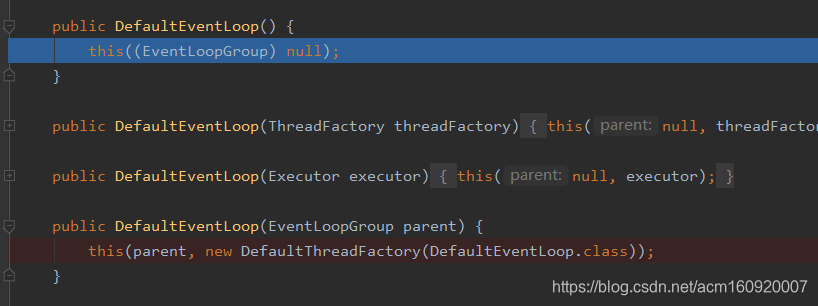Netty源码解析-EventLoop-DefaultEventLoop启动过程
Netty version : 4.1.53.Final
有任何错误或者建议可以留言交流,谢谢
DefaultEventLoop
DefaultEventLoop是EventLoop的一个最简单实现,为方便更好理解后面NioEventLoop做准备。
继承关系

DefaultEventLoop初始化

从new DefaultEventLoop()开始进入

新建一个ThreadFactory对象,主要用来新建线程,同时传入的DefaultEventLoop.class用于帮助生成线程的命名。

到父类SingleThreadEventExecutor

这里新建了一个ThreadPerTaskExecutor对象,该类的主要作用是调用threadfactory的newThread()方法并启动线程

在调用父类的构造方法,一直跟踪代码到SingleThreadEventExecutor的构造方法

这里的addTaskWakesUp属性看意思是添加任务时将线程唤醒。
maxPendingTasks:最多可以有多少任务等待执行。不设置就是Integer.MAX_VALUE
下面赋值操作比较重要,进一步跟进

这个方法返回了一个exector势力,重写了execute方法,这个方法用于使用传入的commend触发executor(ThreadPerTaskExecutor)的execute方法,前面可以看到ThreadPerTaskExecutor的executor方法会新建线程同时执行start()方法。在进入apply方法

这里新建一个匿名任务,用于直接调用commend的run()方法。在返回到SingleThreadEventExecutor类,

这里我们知道了exector属性用来启动一个线程并执行一个任务,这里绕了几层。在后是初始化任务队列和拒绝策略。至此初始化工作大致完成
DefaultEventLoop提交任务

这里分析submit方法。进入代码一直到AbstractExecutorService的submit()方法

这里会执行execute方法,然后跟踪到SingleThreadEventExecutor的方法

这里判断inEventLoop也就是判断当前线程是不是和这个DefaultEventLoop实例绑定的线程。前面没有设置这个属性,所以返回为false,然后添加任务再进入if里面,在跟踪进入startThread方法

这里判断是否已经启动过,然后设置状态,然后进入doStartThread()方法代码如下:
private void doStartThread() {
assert thread == null;
executor.execute(new Runnable() {
@Override
public void run() {
thread = Thread.currentThread();
if (interrupted) {
thread.interrupt();
}
boolean success = false;
updateLastExecutionTime();
try {
SingleThreadEventExecutor.this.run();
success = true;
} catch (Throwable t) {
logger.warn("Unexpected exception from an event executor: ", t);
} finally {
for (;;) {
int oldState = state;
if (oldState >= ST_SHUTTING_DOWN || STATE_UPDATER.compareAndSet(
SingleThreadEventExecutor.this, oldState, ST_SHUTTING_DOWN)) {
break;
}
}
// Check if confirmShutdown() was called at the end of the loop.
if (success && gracefulShutdownStartTime == 0) {
if (logger.isErrorEnabled()) {
logger.error("Buggy " + EventExecutor.class.getSimpleName() + " implementation; " +
SingleThreadEventExecutor.class.getSimpleName() + ".confirmShutdown() must " +
"be called before run() implementation terminates.");
}
}
try {
// Run all remaining tasks and shutdown hooks. At this point the event loop
// is in ST_SHUTTING_DOWN state still accepting tasks which is needed for
// graceful shutdown with quietPeriod.
for (;;) {
if (confirmShutdown()) {
break;
}
}
// Now we want to make sure no more tasks can be added from this point. This is
// achieved by switching the state. Any new tasks beyond this point will be rejected.
for (;;) {
int oldState = state;
if (oldState >= ST_SHUTDOWN || STATE_UPDATER.compareAndSet(
SingleThreadEventExecutor.this, oldState, ST_SHUTDOWN)) {
break;
}
}
// We have the final set of tasks in the queue now, no more can be added, run all remaining.
// No need to loop here, this is the final pass.
confirmShutdown();
} finally {
try {
cleanup();
} finally {
// Lets remove all FastThreadLocals for the Thread as we are about to terminate and notify
// the future. The user may block on the future and once it unblocks the JVM may terminate
// and start unloading classes.
// See https://github.com/netty/netty/issues/6596.
FastThreadLocal.removeAll();
STATE_UPDATER.set(SingleThreadEventExecutor.this, ST_TERMINATED);
threadLock.countDown();
int numUserTasks = drainTasks();
if (numUserTasks > 0 && logger.isWarnEnabled()) {
logger.warn("An event executor terminated with " +
"non-empty task queue (" + numUserTasks + ')');
}
terminationFuture.setSuccess(null);
}
}
}
}
});
}
这里调用exector.execute方法并传入任务,这里这个exector就是前面初始化的时候exector,这个方法会创建一个线程来运行任务。所以进一步会到

这里apply方法再包装了一层并调用run()方法

再到start方法

这个时候我们通过idea调试切换到新建的线程

由于我之前在代码设置了断点 所有新建的线程停止在了断点处

在进入commend.run()方法,也就是之前贴上的代码:

这里绑定thread属性同时调用 SingleThreadEventExecutor.this.run();方法这个方法就是一个死循环,(finally里面的方法暂时还不知道具体意义暂时不分析)这个run方法也就是DefaultEventLoop重写的run()方法
这里获取任务然后执行,如果任务为零,takeTask()方法将会阻塞,如下:
protected Runnable takeTask() {
assert inEventLoop();
if (!(taskQueue instanceof BlockingQueue)) {
throw new UnsupportedOperationException();
}
BlockingQueue<Runnable> taskQueue = (BlockingQueue<Runnable>) this.taskQueue;
for (;;) {
ScheduledFutureTask<?> scheduledTask = peekScheduledTask();
if (scheduledTask == null) {
Runnable task = null;
try {
task = taskQueue.take();
if (task == WAKEUP_TASK) {
task = null;
}
} catch (InterruptedException e) {
// Ignore
}
return task;
} else {
long delayNanos = scheduledTask.delayNanos();
Runnable task = null;
if (delayNanos > 0) {
try {
task = taskQueue.poll(delayNanos, TimeUnit.NANOSECONDS);
} catch (InterruptedException e) {
// Waken up.
return null;
}
}
if (task == null) {
// We need to fetch the scheduled tasks now as otherwise there may be a chance that
// scheduled tasks are never executed if there is always one task in the taskQueue.
// This is for example true for the read task of OIO Transport
// See https://github.com/netty/netty/issues/1614
fetchFromScheduledTaskQueue();
task = taskQueue.poll();
}
if (task != null) {
return task;
}
}
}
}
方法首先判断是否是绑定的线程,然后任务队列是BlockingQueue类型,没有任务将会阻塞,这里有两种任务队列,因为Default本身是实现了ScheduledExecutorService并实现了定时任务的运行,所以这里会从两个队列里面获取任务。
参考资料:
《Netty in action 》 v5
《Netty 4 核心原理》






















 449
449











 被折叠的 条评论
为什么被折叠?
被折叠的 条评论
为什么被折叠?








